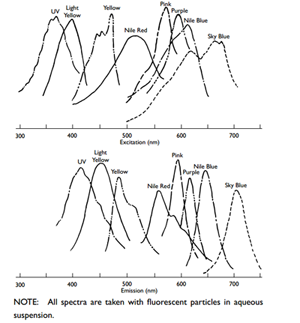Rainbow Beads: Why a Flow User Should Have Them at Hand
| There are several reagents that will make your life easier if you are a regular to flow cytometry. One such reagent is the rainbow bead. Rainbow beads are particles that contain a wide range of fluorophores. This allows for the emission of discrete signals when excited by the various lasers of a flow cytometer. | |
| Simply speaking, the decomposition of natural light reveals that the visible spectrum actually contains a range of colors, from violet to red. As such, you can make your own rainbow with an object capable of separating the colors in the sunlight, like a prism. If you have difficulty remembering this concept or the product name, you can always refer to the cover for Dark Side of the Moon. | |
| There are other interesting ways to make a rainbow, but we'll leave it at that and jump right into flow cytometry. |
| So, about the beads. There are several types of Calibration Rainbow Particles. A commonly used one contains several defined peaks, which correspond to different fluorophore intensities. They can be excited at several wavelengths, covering most lasers included in commercially available flow cytometers. The particles fluoresce in several channels, from all the different lasers. |  Excitation and emission pattern of Rainbow beads |
| How can these beads be useful to you? They are designed to make sure your instrument is well calibrated and performing at its best. For example, you can use them to optimize the machine's alignment. When you stimulate the fluorophores bound to your cell, you want to maximize the signal collected from all lasers, and not favor one over the other(s). You can monitor this by using the beads, just by plotting a channel from one laser against a channel from the other laser: |
|
 |
|
| They are also great for troubleshooting. Suppose that you did your experiment and you don't detect a signal in the PerCP/Cyanine5.5 channel. Several scenarios will come to mind. First, you may think, "The antibody degraded, I have to call Technical Service." We are happy to help out, but before calling us, it may be useful to make sure your instrument is working as it should. A quick way to check on that is by using the Rainbow beads. Someone else may have changed the configuration to detect another color. Also, temperature and other environmental changes can affect the laser performance, and this may be reflected in a loss or reduction in signal. | |
| When using the particles, why not take a short break and listen to Israel "IZ" Kamakawiwo'ole's Somewhere Over the Rainbow. Isn't it beautiful? | |
| Stay tuned for more technical tips and fun stuff. As always, if you have any questions or comments, feel free to let us know: mtam@biolegend.com. Check out our products: Rainbow Particles. Need some help with flow troubleshooting? Check this out. |
|






Follow Us